HRM Report: Conflict, Ethics, Negotiation Strategies for HRM
VerifiedAdded on 2023/06/03
|13
|2915
|449
Report
AI Summary
This report delves into crucial aspects of Human Resource Management (HRM), addressing conflict management, ethical organizational culture, and negotiation strategies. The report begins by examining the nature of conflict in the workplace, differentiating between functional and dysfunctional conflicts, and suggesting training programs, particularly using the Cognitivist learning theory, to promote positive conflict resolution within newly formed teams. The report then explores strategies for fostering and maintaining an ethical organizational culture, emphasizing the 'Power of Reframing' and the importance of ethical codes, training, performance evaluations, and employee involvement. Finally, the report investigates various negotiation preparation strategies, highlighting the integrative (win-win) approach as the most effective for achieving optimal outcomes in HRM contexts. The report uses workplace examples and case studies to support its recommendations, providing a comprehensive overview of key HRM practices.
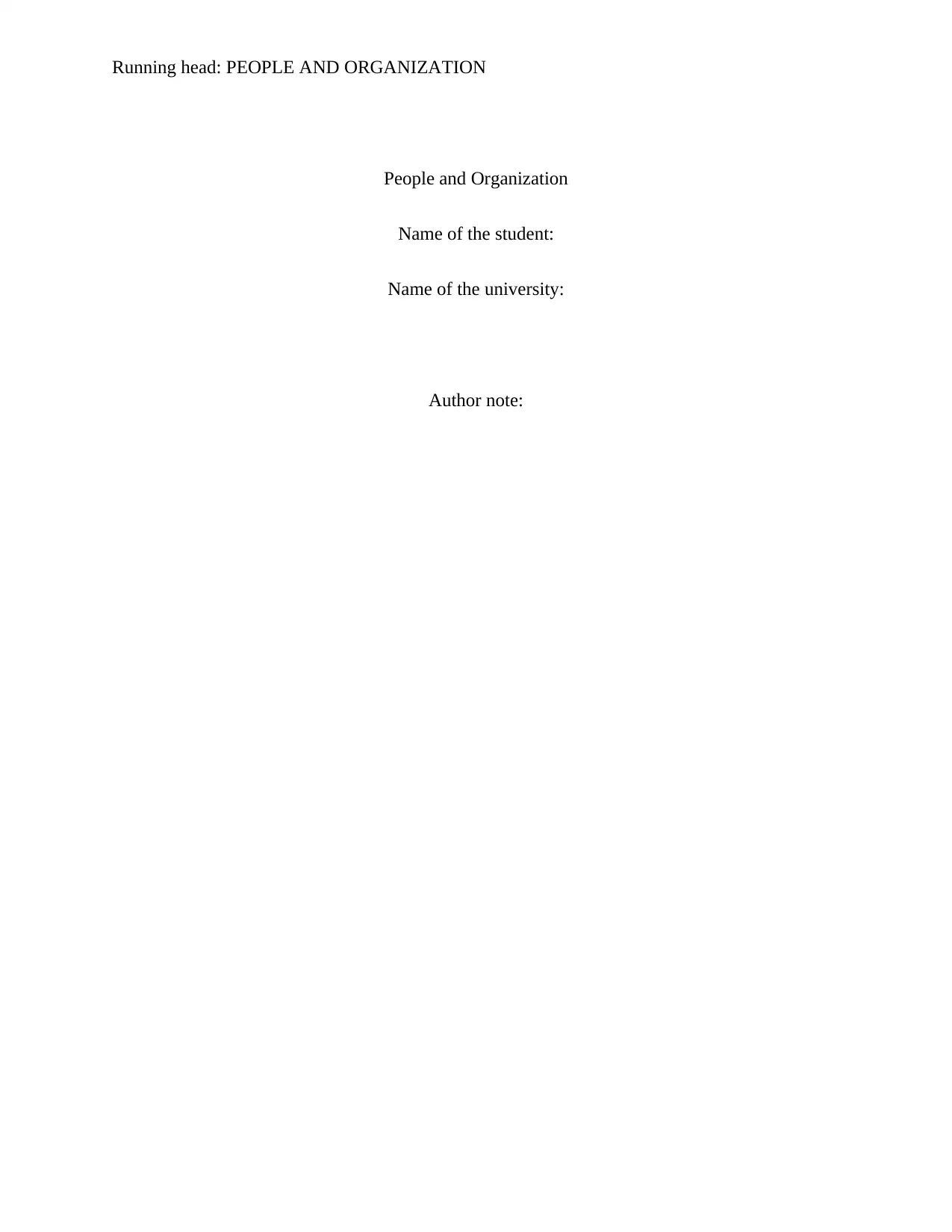
Running head: PEOPLE AND ORGANIZATION
People and Organization
Name of the student:
Name of the university:
Author note:
People and Organization
Name of the student:
Name of the university:
Author note:
Paraphrase This Document
Need a fresh take? Get an instant paraphrase of this document with our AI Paraphraser
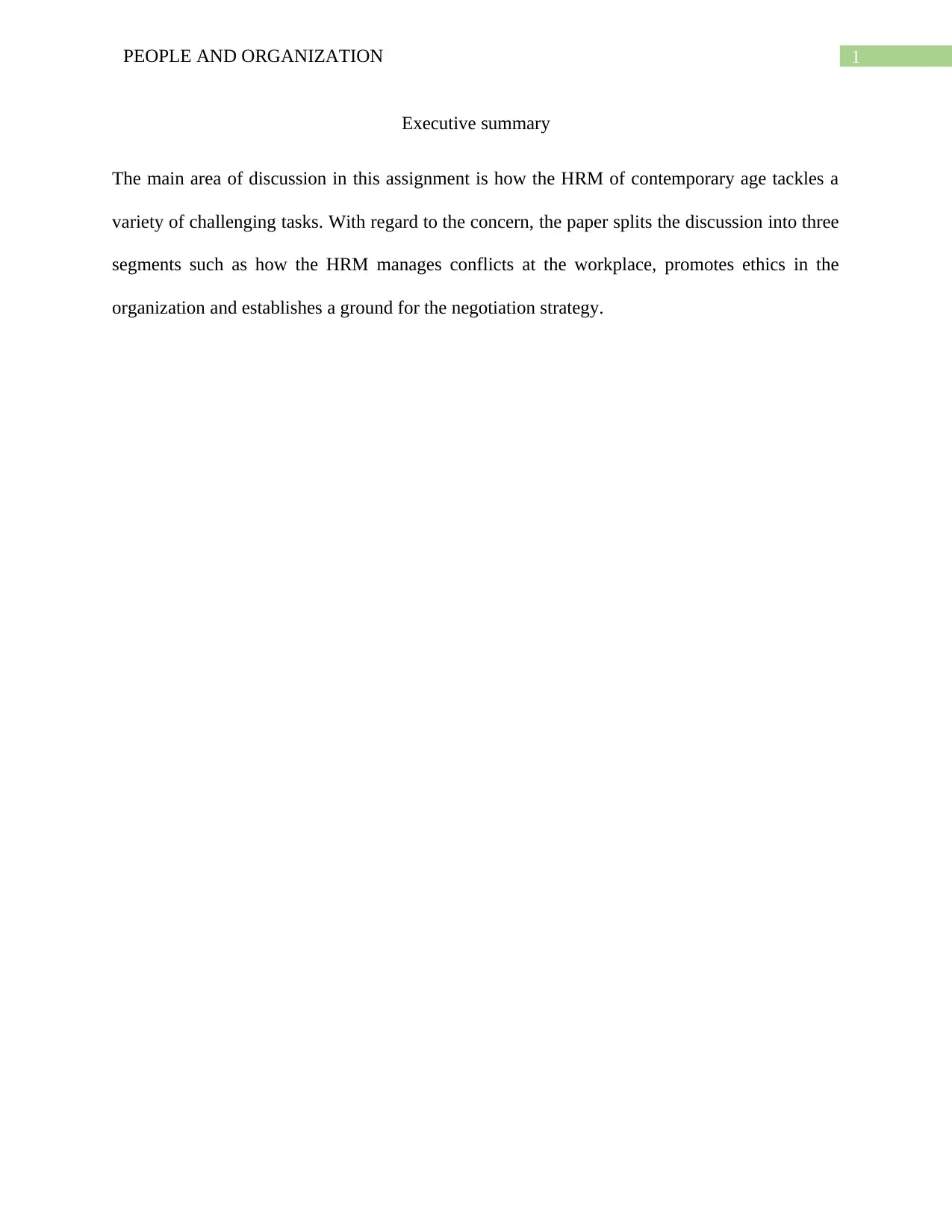
1PEOPLE AND ORGANIZATION
Executive summary
The main area of discussion in this assignment is how the HRM of contemporary age tackles a
variety of challenging tasks. With regard to the concern, the paper splits the discussion into three
segments such as how the HRM manages conflicts at the workplace, promotes ethics in the
organization and establishes a ground for the negotiation strategy.
Executive summary
The main area of discussion in this assignment is how the HRM of contemporary age tackles a
variety of challenging tasks. With regard to the concern, the paper splits the discussion into three
segments such as how the HRM manages conflicts at the workplace, promotes ethics in the
organization and establishes a ground for the negotiation strategy.
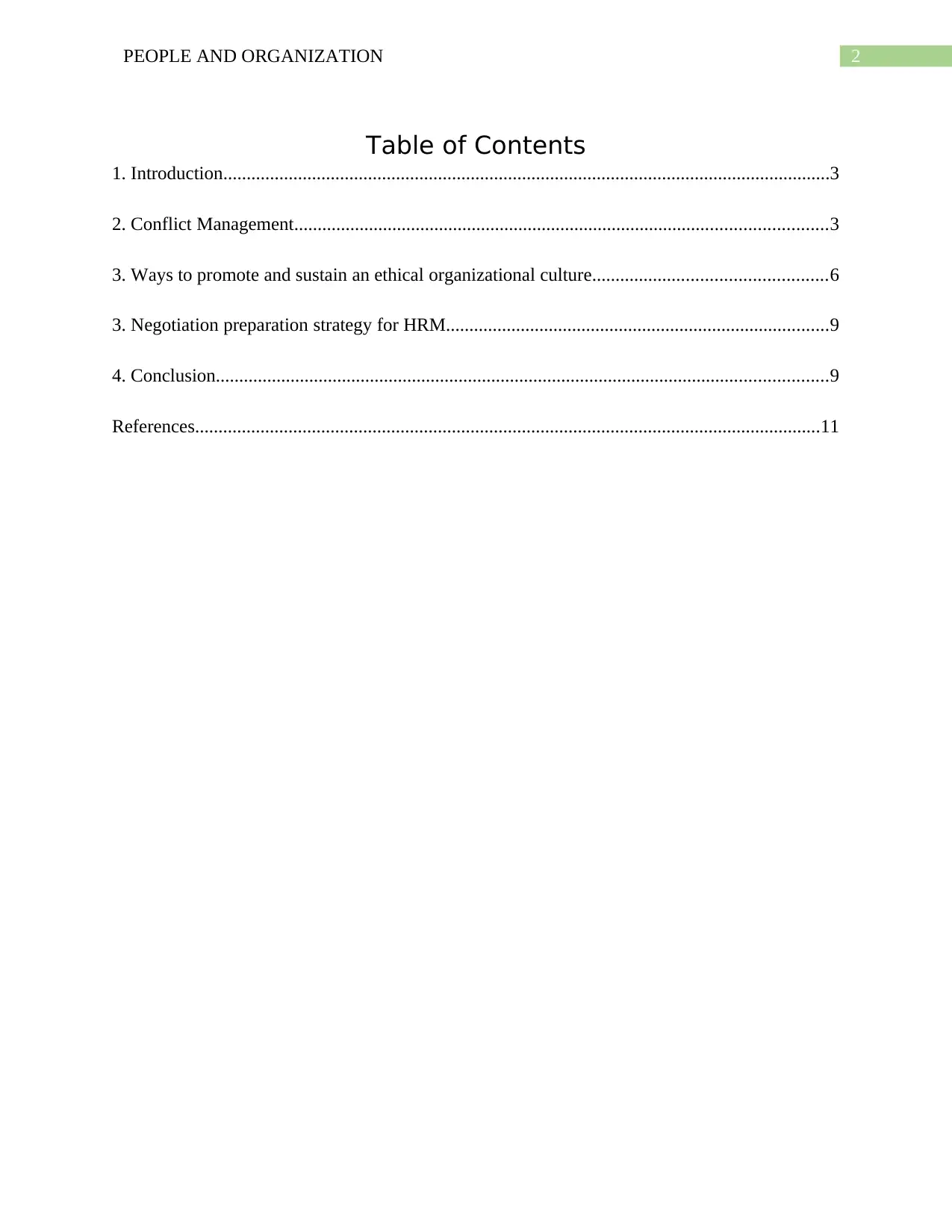
2PEOPLE AND ORGANIZATION
Table of Contents
1. Introduction..................................................................................................................................3
2. Conflict Management..................................................................................................................3
3. Ways to promote and sustain an ethical organizational culture..................................................6
3. Negotiation preparation strategy for HRM..................................................................................9
4. Conclusion...................................................................................................................................9
References......................................................................................................................................11
Table of Contents
1. Introduction..................................................................................................................................3
2. Conflict Management..................................................................................................................3
3. Ways to promote and sustain an ethical organizational culture..................................................6
3. Negotiation preparation strategy for HRM..................................................................................9
4. Conclusion...................................................................................................................................9
References......................................................................................................................................11
⊘ This is a preview!⊘
Do you want full access?
Subscribe today to unlock all pages.

Trusted by 1+ million students worldwide
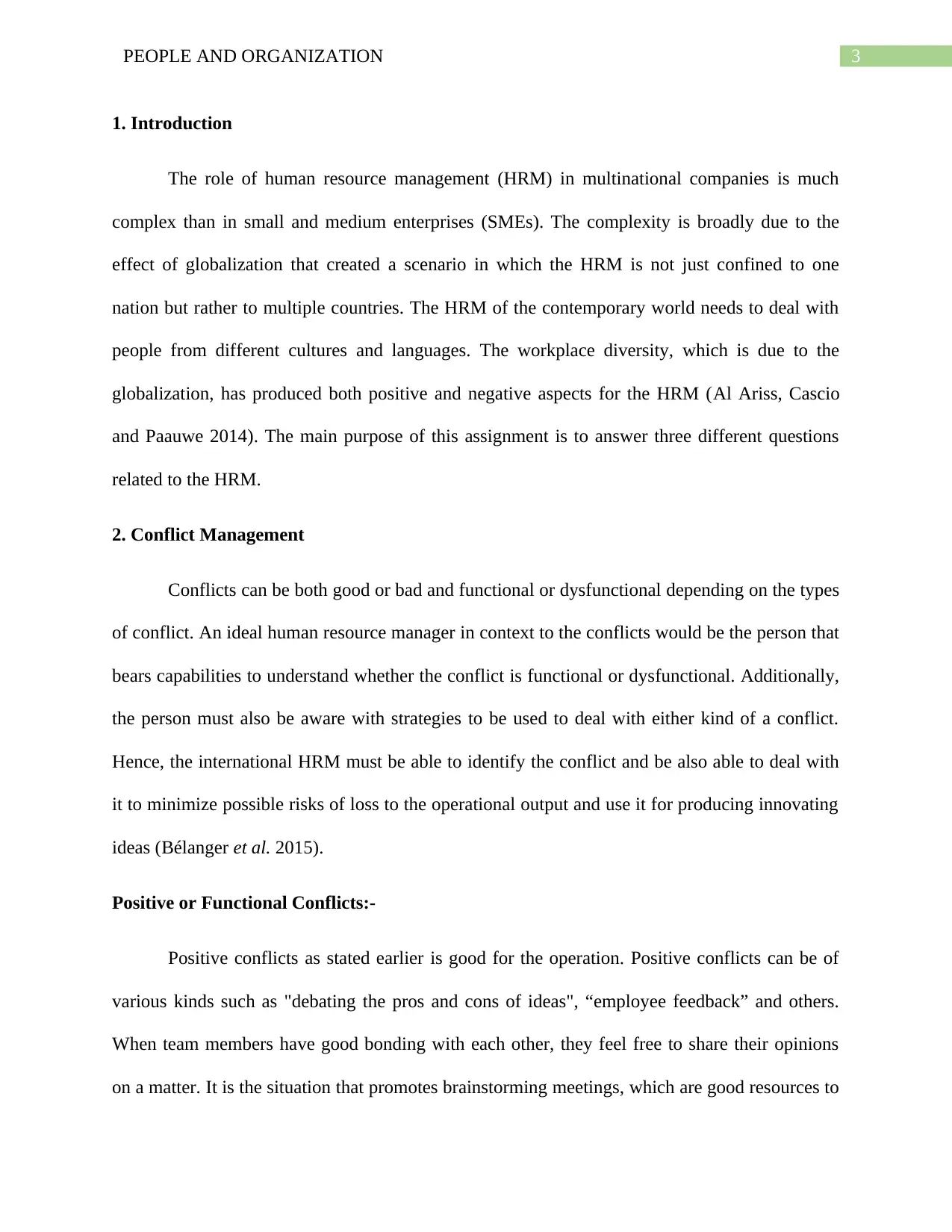
3PEOPLE AND ORGANIZATION
1. Introduction
The role of human resource management (HRM) in multinational companies is much
complex than in small and medium enterprises (SMEs). The complexity is broadly due to the
effect of globalization that created a scenario in which the HRM is not just confined to one
nation but rather to multiple countries. The HRM of the contemporary world needs to deal with
people from different cultures and languages. The workplace diversity, which is due to the
globalization, has produced both positive and negative aspects for the HRM (Al Ariss, Cascio
and Paauwe 2014). The main purpose of this assignment is to answer three different questions
related to the HRM.
2. Conflict Management
Conflicts can be both good or bad and functional or dysfunctional depending on the types
of conflict. An ideal human resource manager in context to the conflicts would be the person that
bears capabilities to understand whether the conflict is functional or dysfunctional. Additionally,
the person must also be aware with strategies to be used to deal with either kind of a conflict.
Hence, the international HRM must be able to identify the conflict and be also able to deal with
it to minimize possible risks of loss to the operational output and use it for producing innovating
ideas (Bélanger et al. 2015).
Positive or Functional Conflicts:-
Positive conflicts as stated earlier is good for the operation. Positive conflicts can be of
various kinds such as "debating the pros and cons of ideas", “employee feedback” and others.
When team members have good bonding with each other, they feel free to share their opinions
on a matter. It is the situation that promotes brainstorming meetings, which are good resources to
1. Introduction
The role of human resource management (HRM) in multinational companies is much
complex than in small and medium enterprises (SMEs). The complexity is broadly due to the
effect of globalization that created a scenario in which the HRM is not just confined to one
nation but rather to multiple countries. The HRM of the contemporary world needs to deal with
people from different cultures and languages. The workplace diversity, which is due to the
globalization, has produced both positive and negative aspects for the HRM (Al Ariss, Cascio
and Paauwe 2014). The main purpose of this assignment is to answer three different questions
related to the HRM.
2. Conflict Management
Conflicts can be both good or bad and functional or dysfunctional depending on the types
of conflict. An ideal human resource manager in context to the conflicts would be the person that
bears capabilities to understand whether the conflict is functional or dysfunctional. Additionally,
the person must also be aware with strategies to be used to deal with either kind of a conflict.
Hence, the international HRM must be able to identify the conflict and be also able to deal with
it to minimize possible risks of loss to the operational output and use it for producing innovating
ideas (Bélanger et al. 2015).
Positive or Functional Conflicts:-
Positive conflicts as stated earlier is good for the operation. Positive conflicts can be of
various kinds such as "debating the pros and cons of ideas", “employee feedback” and others.
When team members have good bonding with each other, they feel free to share their opinions
on a matter. It is the situation that promotes brainstorming meetings, which are good resources to
Paraphrase This Document
Need a fresh take? Get an instant paraphrase of this document with our AI Paraphraser
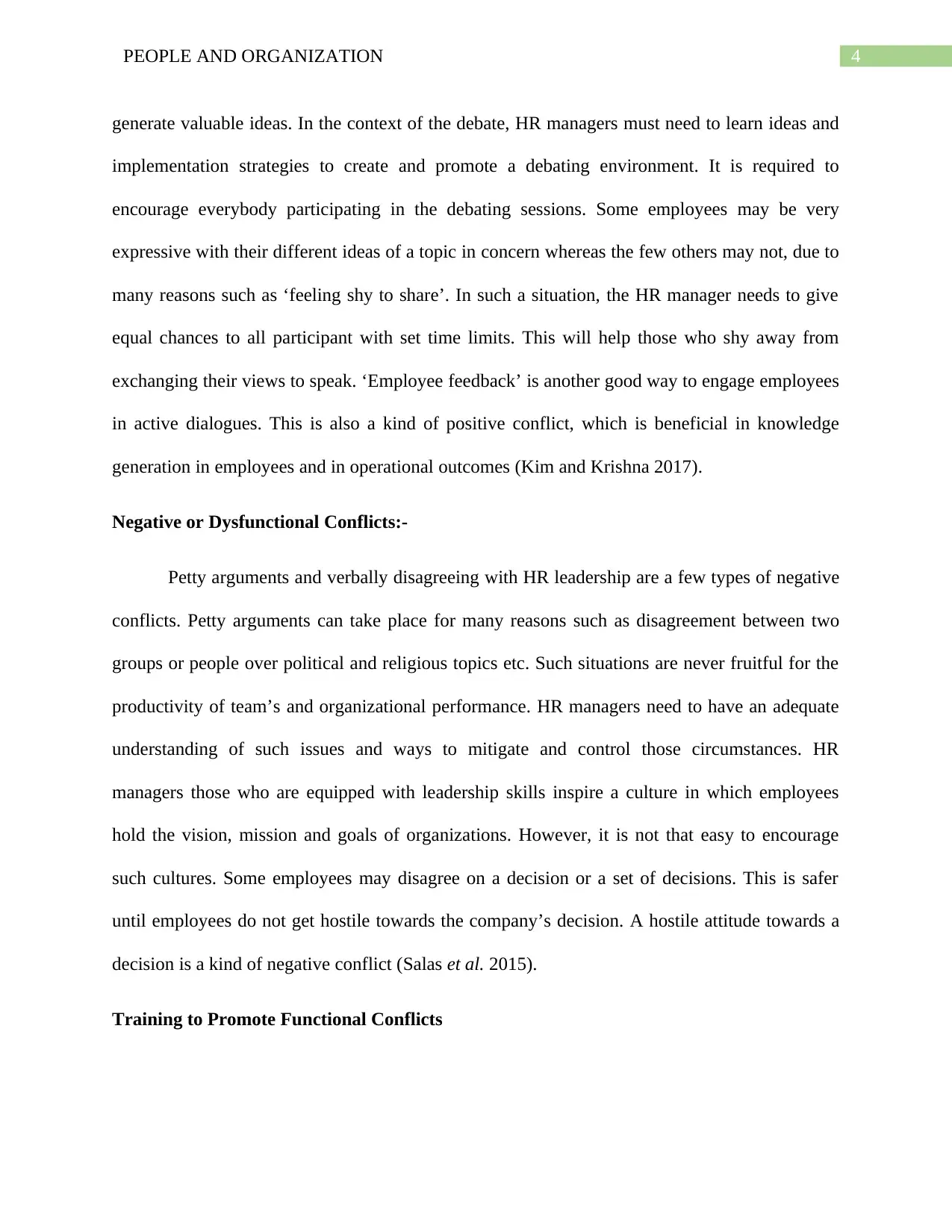
4PEOPLE AND ORGANIZATION
generate valuable ideas. In the context of the debate, HR managers must need to learn ideas and
implementation strategies to create and promote a debating environment. It is required to
encourage everybody participating in the debating sessions. Some employees may be very
expressive with their different ideas of a topic in concern whereas the few others may not, due to
many reasons such as ‘feeling shy to share’. In such a situation, the HR manager needs to give
equal chances to all participant with set time limits. This will help those who shy away from
exchanging their views to speak. ‘Employee feedback’ is another good way to engage employees
in active dialogues. This is also a kind of positive conflict, which is beneficial in knowledge
generation in employees and in operational outcomes (Kim and Krishna 2017).
Negative or Dysfunctional Conflicts:-
Petty arguments and verbally disagreeing with HR leadership are a few types of negative
conflicts. Petty arguments can take place for many reasons such as disagreement between two
groups or people over political and religious topics etc. Such situations are never fruitful for the
productivity of team’s and organizational performance. HR managers need to have an adequate
understanding of such issues and ways to mitigate and control those circumstances. HR
managers those who are equipped with leadership skills inspire a culture in which employees
hold the vision, mission and goals of organizations. However, it is not that easy to encourage
such cultures. Some employees may disagree on a decision or a set of decisions. This is safer
until employees do not get hostile towards the company’s decision. A hostile attitude towards a
decision is a kind of negative conflict (Salas et al. 2015).
Training to Promote Functional Conflicts
generate valuable ideas. In the context of the debate, HR managers must need to learn ideas and
implementation strategies to create and promote a debating environment. It is required to
encourage everybody participating in the debating sessions. Some employees may be very
expressive with their different ideas of a topic in concern whereas the few others may not, due to
many reasons such as ‘feeling shy to share’. In such a situation, the HR manager needs to give
equal chances to all participant with set time limits. This will help those who shy away from
exchanging their views to speak. ‘Employee feedback’ is another good way to engage employees
in active dialogues. This is also a kind of positive conflict, which is beneficial in knowledge
generation in employees and in operational outcomes (Kim and Krishna 2017).
Negative or Dysfunctional Conflicts:-
Petty arguments and verbally disagreeing with HR leadership are a few types of negative
conflicts. Petty arguments can take place for many reasons such as disagreement between two
groups or people over political and religious topics etc. Such situations are never fruitful for the
productivity of team’s and organizational performance. HR managers need to have an adequate
understanding of such issues and ways to mitigate and control those circumstances. HR
managers those who are equipped with leadership skills inspire a culture in which employees
hold the vision, mission and goals of organizations. However, it is not that easy to encourage
such cultures. Some employees may disagree on a decision or a set of decisions. This is safer
until employees do not get hostile towards the company’s decision. A hostile attitude towards a
decision is a kind of negative conflict (Salas et al. 2015).
Training to Promote Functional Conflicts
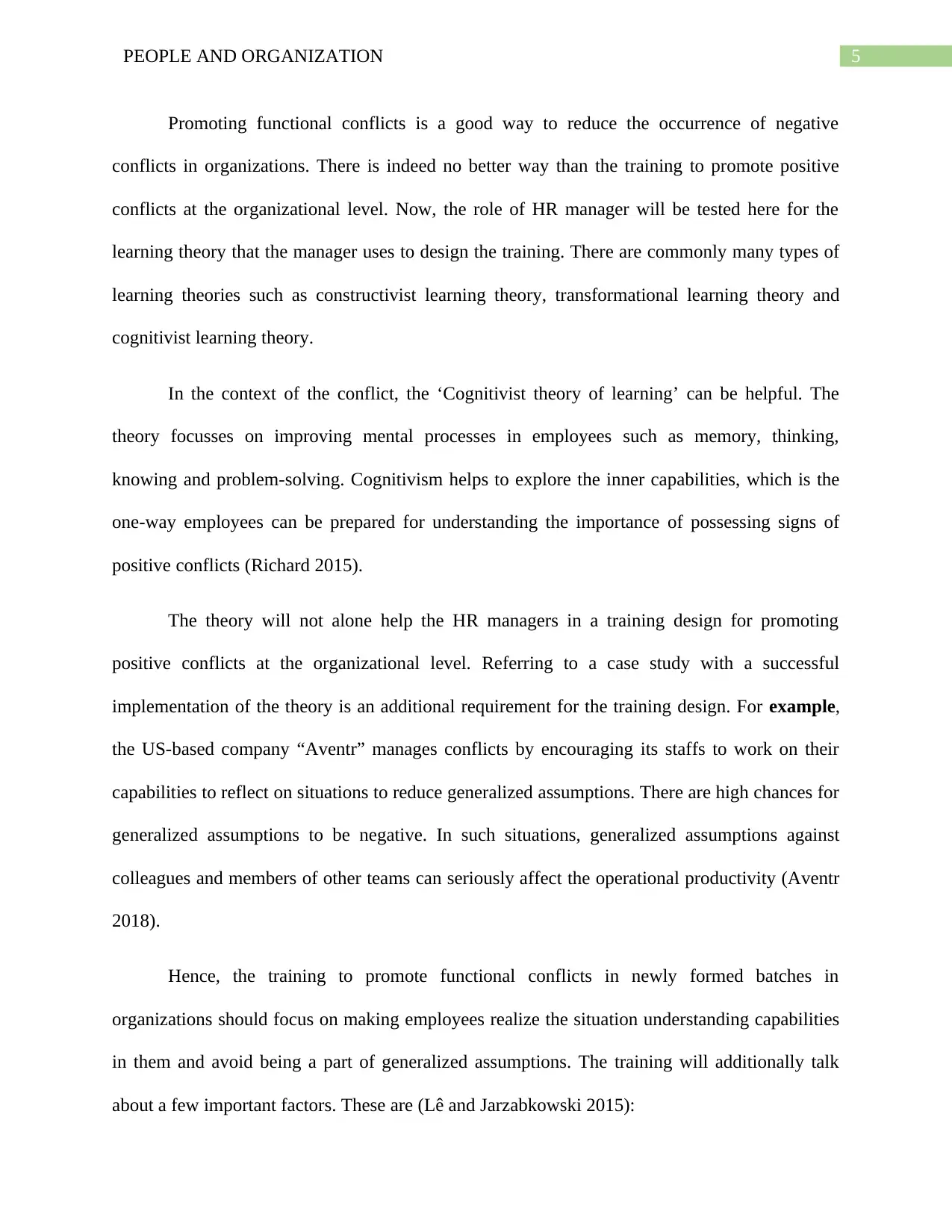
5PEOPLE AND ORGANIZATION
Promoting functional conflicts is a good way to reduce the occurrence of negative
conflicts in organizations. There is indeed no better way than the training to promote positive
conflicts at the organizational level. Now, the role of HR manager will be tested here for the
learning theory that the manager uses to design the training. There are commonly many types of
learning theories such as constructivist learning theory, transformational learning theory and
cognitivist learning theory.
In the context of the conflict, the ‘Cognitivist theory of learning’ can be helpful. The
theory focusses on improving mental processes in employees such as memory, thinking,
knowing and problem-solving. Cognitivism helps to explore the inner capabilities, which is the
one-way employees can be prepared for understanding the importance of possessing signs of
positive conflicts (Richard 2015).
The theory will not alone help the HR managers in a training design for promoting
positive conflicts at the organizational level. Referring to a case study with a successful
implementation of the theory is an additional requirement for the training design. For example,
the US-based company “Aventr” manages conflicts by encouraging its staffs to work on their
capabilities to reflect on situations to reduce generalized assumptions. There are high chances for
generalized assumptions to be negative. In such situations, generalized assumptions against
colleagues and members of other teams can seriously affect the operational productivity (Aventr
2018).
Hence, the training to promote functional conflicts in newly formed batches in
organizations should focus on making employees realize the situation understanding capabilities
in them and avoid being a part of generalized assumptions. The training will additionally talk
about a few important factors. These are (Lê and Jarzabkowski 2015):
Promoting functional conflicts is a good way to reduce the occurrence of negative
conflicts in organizations. There is indeed no better way than the training to promote positive
conflicts at the organizational level. Now, the role of HR manager will be tested here for the
learning theory that the manager uses to design the training. There are commonly many types of
learning theories such as constructivist learning theory, transformational learning theory and
cognitivist learning theory.
In the context of the conflict, the ‘Cognitivist theory of learning’ can be helpful. The
theory focusses on improving mental processes in employees such as memory, thinking,
knowing and problem-solving. Cognitivism helps to explore the inner capabilities, which is the
one-way employees can be prepared for understanding the importance of possessing signs of
positive conflicts (Richard 2015).
The theory will not alone help the HR managers in a training design for promoting
positive conflicts at the organizational level. Referring to a case study with a successful
implementation of the theory is an additional requirement for the training design. For example,
the US-based company “Aventr” manages conflicts by encouraging its staffs to work on their
capabilities to reflect on situations to reduce generalized assumptions. There are high chances for
generalized assumptions to be negative. In such situations, generalized assumptions against
colleagues and members of other teams can seriously affect the operational productivity (Aventr
2018).
Hence, the training to promote functional conflicts in newly formed batches in
organizations should focus on making employees realize the situation understanding capabilities
in them and avoid being a part of generalized assumptions. The training will additionally talk
about a few important factors. These are (Lê and Jarzabkowski 2015):
⊘ This is a preview!⊘
Do you want full access?
Subscribe today to unlock all pages.

Trusted by 1+ million students worldwide
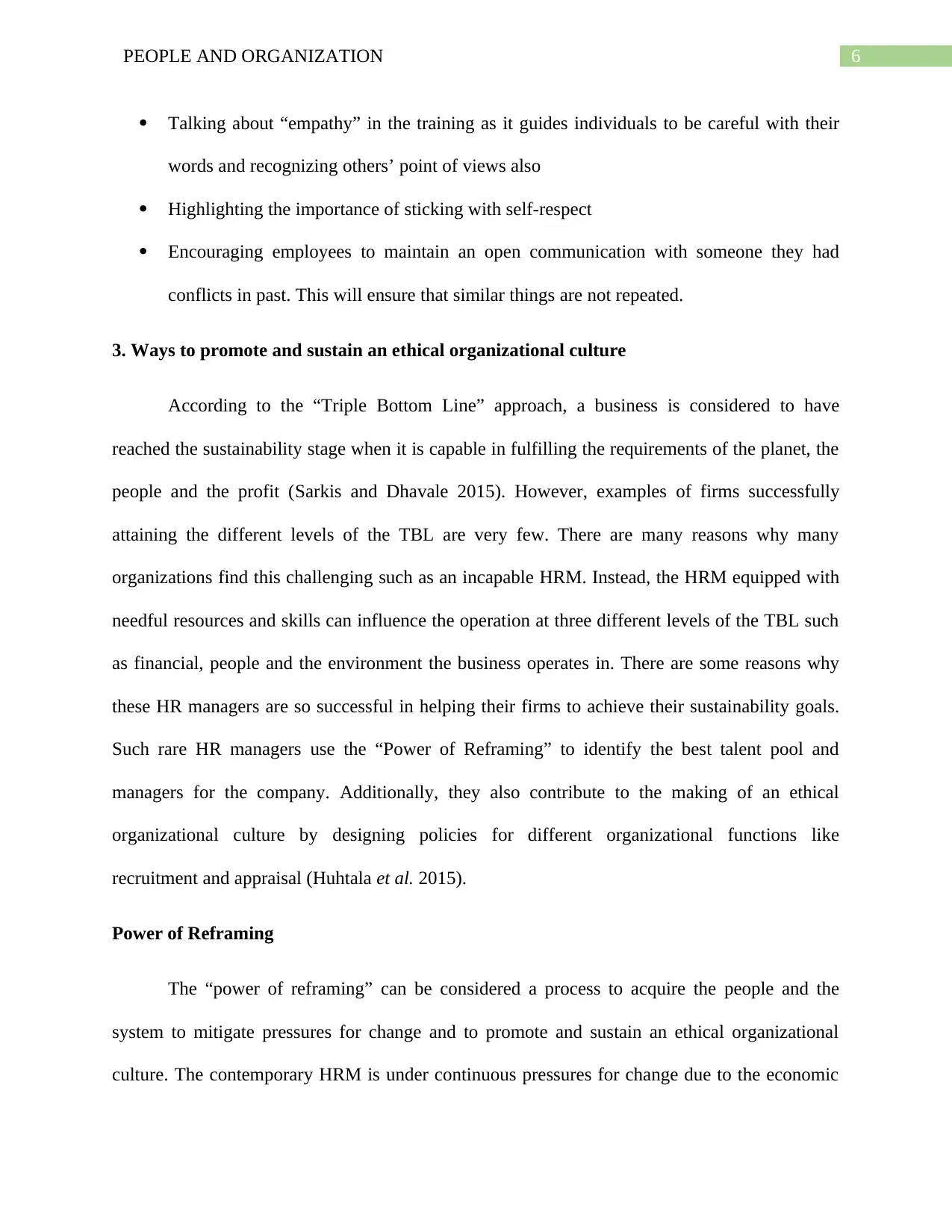
6PEOPLE AND ORGANIZATION
Talking about “empathy” in the training as it guides individuals to be careful with their
words and recognizing others’ point of views also
Highlighting the importance of sticking with self-respect
Encouraging employees to maintain an open communication with someone they had
conflicts in past. This will ensure that similar things are not repeated.
3. Ways to promote and sustain an ethical organizational culture
According to the “Triple Bottom Line” approach, a business is considered to have
reached the sustainability stage when it is capable in fulfilling the requirements of the planet, the
people and the profit (Sarkis and Dhavale 2015). However, examples of firms successfully
attaining the different levels of the TBL are very few. There are many reasons why many
organizations find this challenging such as an incapable HRM. Instead, the HRM equipped with
needful resources and skills can influence the operation at three different levels of the TBL such
as financial, people and the environment the business operates in. There are some reasons why
these HR managers are so successful in helping their firms to achieve their sustainability goals.
Such rare HR managers use the “Power of Reframing” to identify the best talent pool and
managers for the company. Additionally, they also contribute to the making of an ethical
organizational culture by designing policies for different organizational functions like
recruitment and appraisal (Huhtala et al. 2015).
Power of Reframing
The “power of reframing” can be considered a process to acquire the people and the
system to mitigate pressures for change and to promote and sustain an ethical organizational
culture. The contemporary HRM is under continuous pressures for change due to the economic
Talking about “empathy” in the training as it guides individuals to be careful with their
words and recognizing others’ point of views also
Highlighting the importance of sticking with self-respect
Encouraging employees to maintain an open communication with someone they had
conflicts in past. This will ensure that similar things are not repeated.
3. Ways to promote and sustain an ethical organizational culture
According to the “Triple Bottom Line” approach, a business is considered to have
reached the sustainability stage when it is capable in fulfilling the requirements of the planet, the
people and the profit (Sarkis and Dhavale 2015). However, examples of firms successfully
attaining the different levels of the TBL are very few. There are many reasons why many
organizations find this challenging such as an incapable HRM. Instead, the HRM equipped with
needful resources and skills can influence the operation at three different levels of the TBL such
as financial, people and the environment the business operates in. There are some reasons why
these HR managers are so successful in helping their firms to achieve their sustainability goals.
Such rare HR managers use the “Power of Reframing” to identify the best talent pool and
managers for the company. Additionally, they also contribute to the making of an ethical
organizational culture by designing policies for different organizational functions like
recruitment and appraisal (Huhtala et al. 2015).
Power of Reframing
The “power of reframing” can be considered a process to acquire the people and the
system to mitigate pressures for change and to promote and sustain an ethical organizational
culture. The contemporary HRM is under continuous pressures for change due to the economic
Paraphrase This Document
Need a fresh take? Get an instant paraphrase of this document with our AI Paraphraser
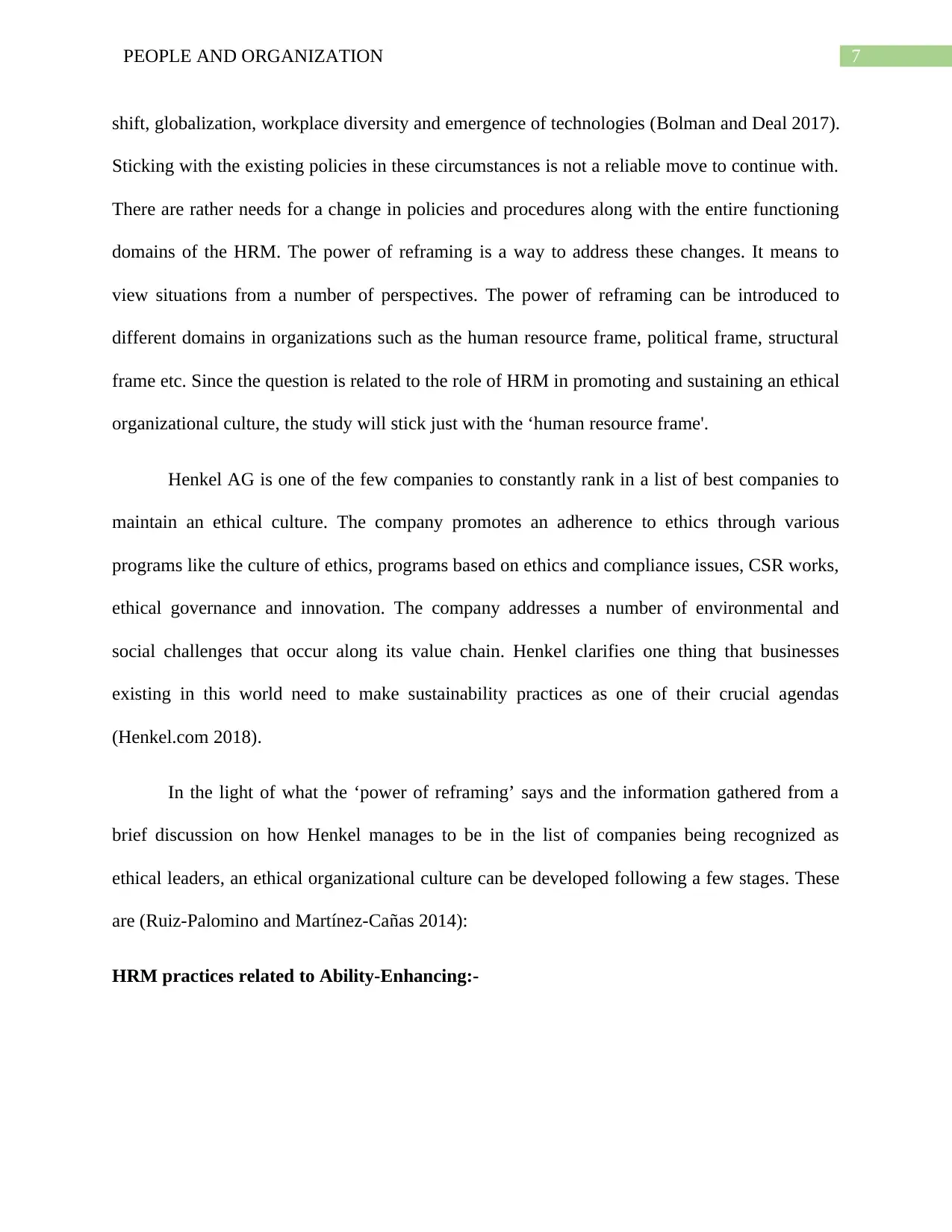
7PEOPLE AND ORGANIZATION
shift, globalization, workplace diversity and emergence of technologies (Bolman and Deal 2017).
Sticking with the existing policies in these circumstances is not a reliable move to continue with.
There are rather needs for a change in policies and procedures along with the entire functioning
domains of the HRM. The power of reframing is a way to address these changes. It means to
view situations from a number of perspectives. The power of reframing can be introduced to
different domains in organizations such as the human resource frame, political frame, structural
frame etc. Since the question is related to the role of HRM in promoting and sustaining an ethical
organizational culture, the study will stick just with the ‘human resource frame'.
Henkel AG is one of the few companies to constantly rank in a list of best companies to
maintain an ethical culture. The company promotes an adherence to ethics through various
programs like the culture of ethics, programs based on ethics and compliance issues, CSR works,
ethical governance and innovation. The company addresses a number of environmental and
social challenges that occur along its value chain. Henkel clarifies one thing that businesses
existing in this world need to make sustainability practices as one of their crucial agendas
(Henkel.com 2018).
In the light of what the ‘power of reframing’ says and the information gathered from a
brief discussion on how Henkel manages to be in the list of companies being recognized as
ethical leaders, an ethical organizational culture can be developed following a few stages. These
are (Ruiz-Palomino and Martínez-Cañas 2014):
HRM practices related to Ability-Enhancing:-
shift, globalization, workplace diversity and emergence of technologies (Bolman and Deal 2017).
Sticking with the existing policies in these circumstances is not a reliable move to continue with.
There are rather needs for a change in policies and procedures along with the entire functioning
domains of the HRM. The power of reframing is a way to address these changes. It means to
view situations from a number of perspectives. The power of reframing can be introduced to
different domains in organizations such as the human resource frame, political frame, structural
frame etc. Since the question is related to the role of HRM in promoting and sustaining an ethical
organizational culture, the study will stick just with the ‘human resource frame'.
Henkel AG is one of the few companies to constantly rank in a list of best companies to
maintain an ethical culture. The company promotes an adherence to ethics through various
programs like the culture of ethics, programs based on ethics and compliance issues, CSR works,
ethical governance and innovation. The company addresses a number of environmental and
social challenges that occur along its value chain. Henkel clarifies one thing that businesses
existing in this world need to make sustainability practices as one of their crucial agendas
(Henkel.com 2018).
In the light of what the ‘power of reframing’ says and the information gathered from a
brief discussion on how Henkel manages to be in the list of companies being recognized as
ethical leaders, an ethical organizational culture can be developed following a few stages. These
are (Ruiz-Palomino and Martínez-Cañas 2014):
HRM practices related to Ability-Enhancing:-
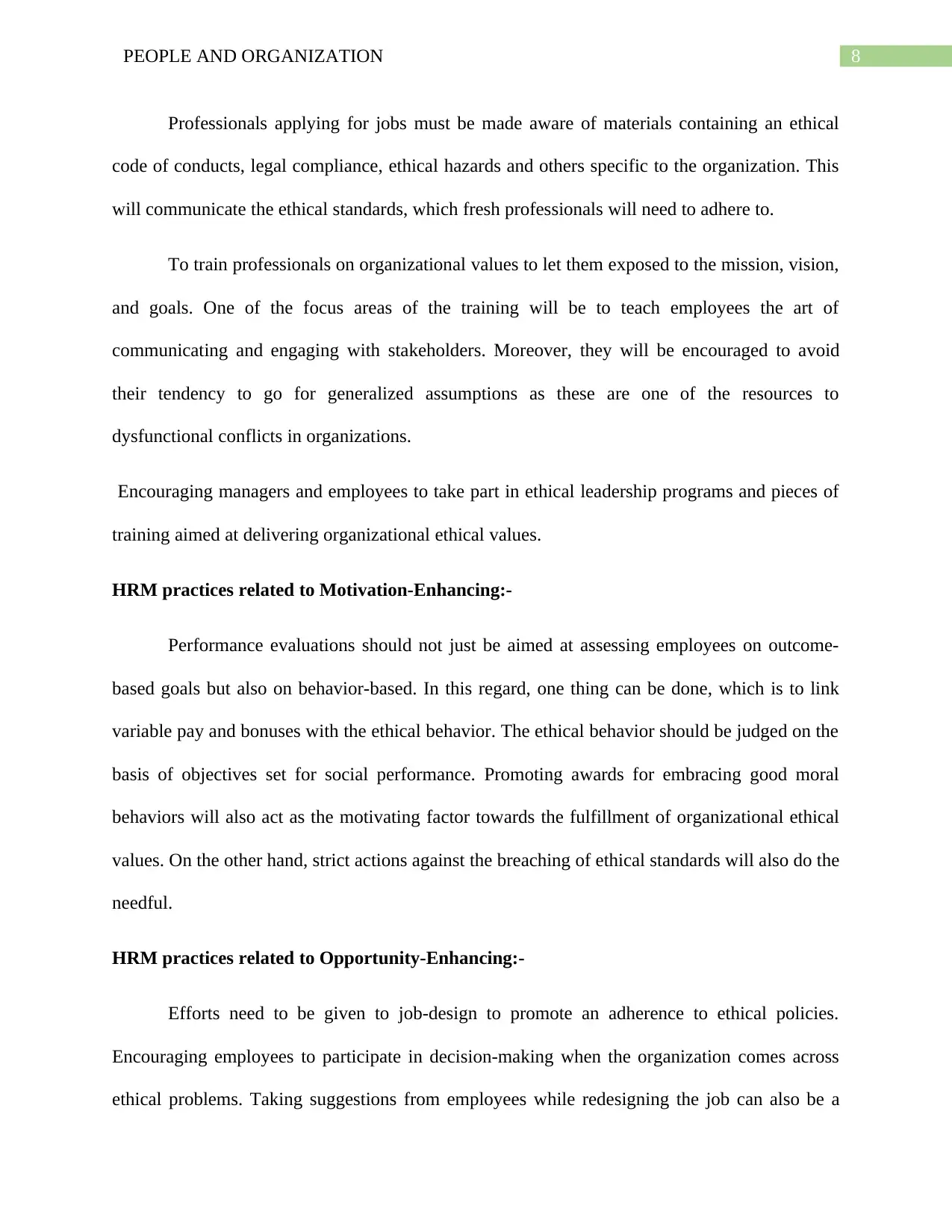
8PEOPLE AND ORGANIZATION
Professionals applying for jobs must be made aware of materials containing an ethical
code of conducts, legal compliance, ethical hazards and others specific to the organization. This
will communicate the ethical standards, which fresh professionals will need to adhere to.
To train professionals on organizational values to let them exposed to the mission, vision,
and goals. One of the focus areas of the training will be to teach employees the art of
communicating and engaging with stakeholders. Moreover, they will be encouraged to avoid
their tendency to go for generalized assumptions as these are one of the resources to
dysfunctional conflicts in organizations.
Encouraging managers and employees to take part in ethical leadership programs and pieces of
training aimed at delivering organizational ethical values.
HRM practices related to Motivation-Enhancing:-
Performance evaluations should not just be aimed at assessing employees on outcome-
based goals but also on behavior-based. In this regard, one thing can be done, which is to link
variable pay and bonuses with the ethical behavior. The ethical behavior should be judged on the
basis of objectives set for social performance. Promoting awards for embracing good moral
behaviors will also act as the motivating factor towards the fulfillment of organizational ethical
values. On the other hand, strict actions against the breaching of ethical standards will also do the
needful.
HRM practices related to Opportunity-Enhancing:-
Efforts need to be given to job-design to promote an adherence to ethical policies.
Encouraging employees to participate in decision-making when the organization comes across
ethical problems. Taking suggestions from employees while redesigning the job can also be a
Professionals applying for jobs must be made aware of materials containing an ethical
code of conducts, legal compliance, ethical hazards and others specific to the organization. This
will communicate the ethical standards, which fresh professionals will need to adhere to.
To train professionals on organizational values to let them exposed to the mission, vision,
and goals. One of the focus areas of the training will be to teach employees the art of
communicating and engaging with stakeholders. Moreover, they will be encouraged to avoid
their tendency to go for generalized assumptions as these are one of the resources to
dysfunctional conflicts in organizations.
Encouraging managers and employees to take part in ethical leadership programs and pieces of
training aimed at delivering organizational ethical values.
HRM practices related to Motivation-Enhancing:-
Performance evaluations should not just be aimed at assessing employees on outcome-
based goals but also on behavior-based. In this regard, one thing can be done, which is to link
variable pay and bonuses with the ethical behavior. The ethical behavior should be judged on the
basis of objectives set for social performance. Promoting awards for embracing good moral
behaviors will also act as the motivating factor towards the fulfillment of organizational ethical
values. On the other hand, strict actions against the breaching of ethical standards will also do the
needful.
HRM practices related to Opportunity-Enhancing:-
Efforts need to be given to job-design to promote an adherence to ethical policies.
Encouraging employees to participate in decision-making when the organization comes across
ethical problems. Taking suggestions from employees while redesigning the job can also be a
⊘ This is a preview!⊘
Do you want full access?
Subscribe today to unlock all pages.

Trusted by 1+ million students worldwide
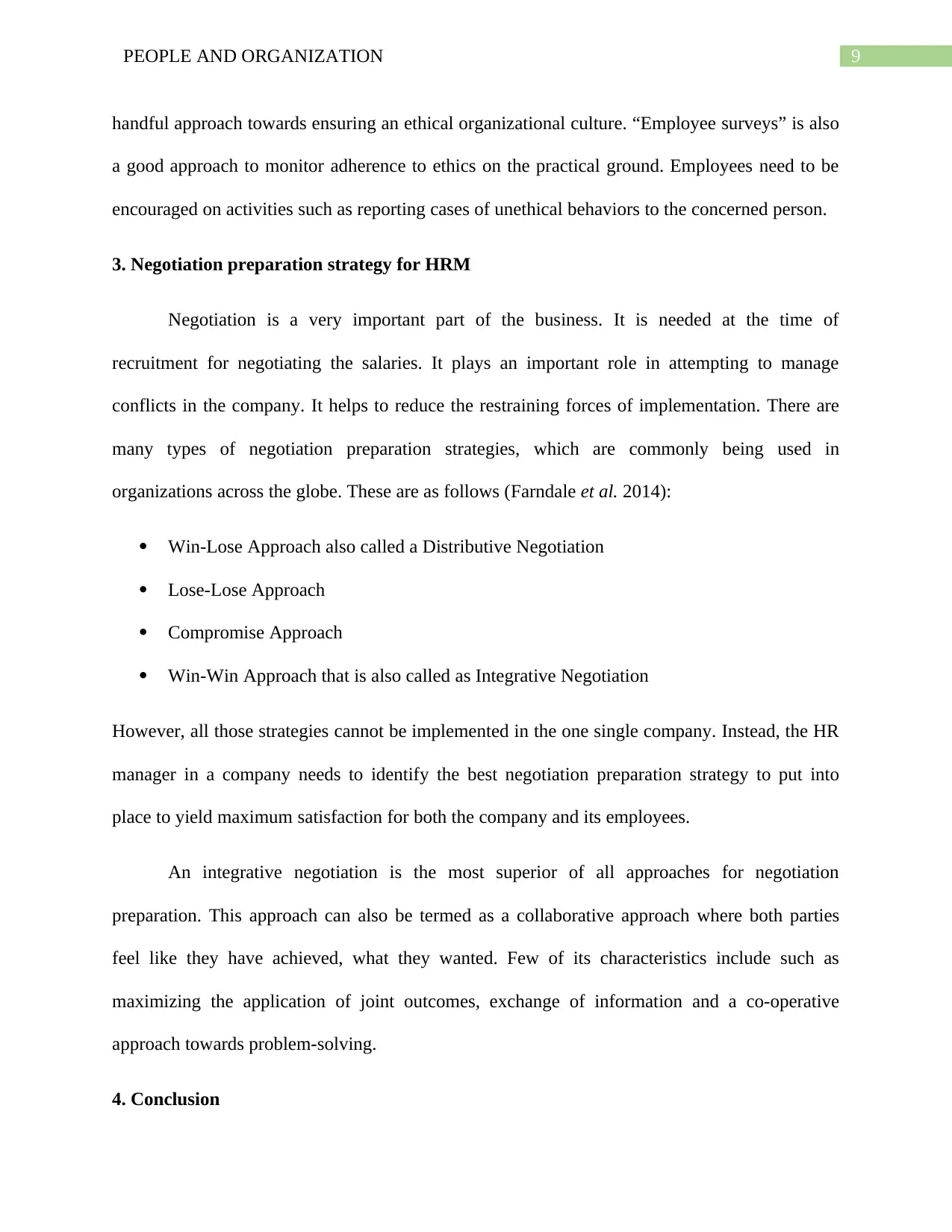
9PEOPLE AND ORGANIZATION
handful approach towards ensuring an ethical organizational culture. “Employee surveys” is also
a good approach to monitor adherence to ethics on the practical ground. Employees need to be
encouraged on activities such as reporting cases of unethical behaviors to the concerned person.
3. Negotiation preparation strategy for HRM
Negotiation is a very important part of the business. It is needed at the time of
recruitment for negotiating the salaries. It plays an important role in attempting to manage
conflicts in the company. It helps to reduce the restraining forces of implementation. There are
many types of negotiation preparation strategies, which are commonly being used in
organizations across the globe. These are as follows (Farndale et al. 2014):
Win-Lose Approach also called a Distributive Negotiation
Lose-Lose Approach
Compromise Approach
Win-Win Approach that is also called as Integrative Negotiation
However, all those strategies cannot be implemented in the one single company. Instead, the HR
manager in a company needs to identify the best negotiation preparation strategy to put into
place to yield maximum satisfaction for both the company and its employees.
An integrative negotiation is the most superior of all approaches for negotiation
preparation. This approach can also be termed as a collaborative approach where both parties
feel like they have achieved, what they wanted. Few of its characteristics include such as
maximizing the application of joint outcomes, exchange of information and a co-operative
approach towards problem-solving.
4. Conclusion
handful approach towards ensuring an ethical organizational culture. “Employee surveys” is also
a good approach to monitor adherence to ethics on the practical ground. Employees need to be
encouraged on activities such as reporting cases of unethical behaviors to the concerned person.
3. Negotiation preparation strategy for HRM
Negotiation is a very important part of the business. It is needed at the time of
recruitment for negotiating the salaries. It plays an important role in attempting to manage
conflicts in the company. It helps to reduce the restraining forces of implementation. There are
many types of negotiation preparation strategies, which are commonly being used in
organizations across the globe. These are as follows (Farndale et al. 2014):
Win-Lose Approach also called a Distributive Negotiation
Lose-Lose Approach
Compromise Approach
Win-Win Approach that is also called as Integrative Negotiation
However, all those strategies cannot be implemented in the one single company. Instead, the HR
manager in a company needs to identify the best negotiation preparation strategy to put into
place to yield maximum satisfaction for both the company and its employees.
An integrative negotiation is the most superior of all approaches for negotiation
preparation. This approach can also be termed as a collaborative approach where both parties
feel like they have achieved, what they wanted. Few of its characteristics include such as
maximizing the application of joint outcomes, exchange of information and a co-operative
approach towards problem-solving.
4. Conclusion
Paraphrase This Document
Need a fresh take? Get an instant paraphrase of this document with our AI Paraphraser
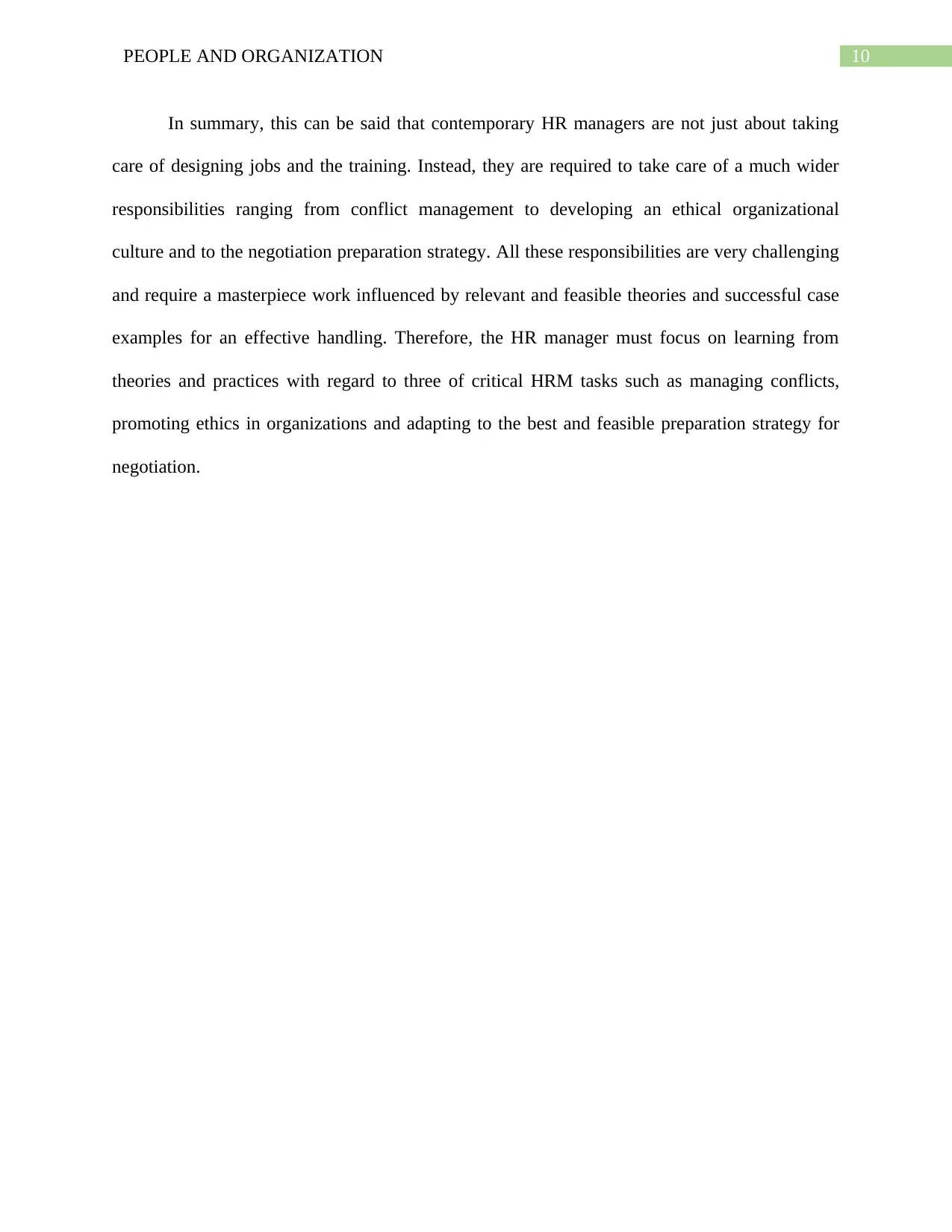
10PEOPLE AND ORGANIZATION
In summary, this can be said that contemporary HR managers are not just about taking
care of designing jobs and the training. Instead, they are required to take care of a much wider
responsibilities ranging from conflict management to developing an ethical organizational
culture and to the negotiation preparation strategy. All these responsibilities are very challenging
and require a masterpiece work influenced by relevant and feasible theories and successful case
examples for an effective handling. Therefore, the HR manager must focus on learning from
theories and practices with regard to three of critical HRM tasks such as managing conflicts,
promoting ethics in organizations and adapting to the best and feasible preparation strategy for
negotiation.
In summary, this can be said that contemporary HR managers are not just about taking
care of designing jobs and the training. Instead, they are required to take care of a much wider
responsibilities ranging from conflict management to developing an ethical organizational
culture and to the negotiation preparation strategy. All these responsibilities are very challenging
and require a masterpiece work influenced by relevant and feasible theories and successful case
examples for an effective handling. Therefore, the HR manager must focus on learning from
theories and practices with regard to three of critical HRM tasks such as managing conflicts,
promoting ethics in organizations and adapting to the best and feasible preparation strategy for
negotiation.
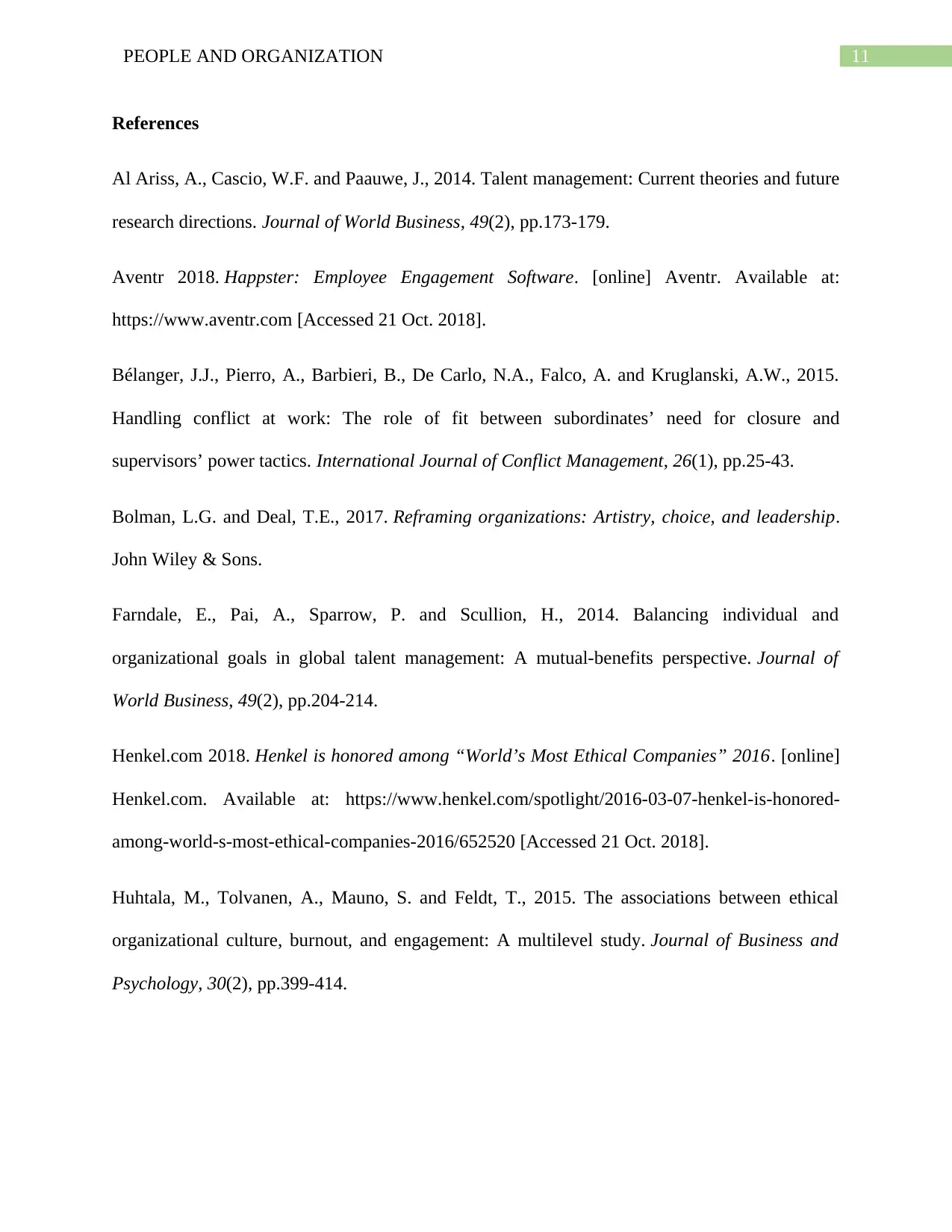
11PEOPLE AND ORGANIZATION
References
Al Ariss, A., Cascio, W.F. and Paauwe, J., 2014. Talent management: Current theories and future
research directions. Journal of World Business, 49(2), pp.173-179.
Aventr 2018. Happster: Employee Engagement Software. [online] Aventr. Available at:
https://www.aventr.com [Accessed 21 Oct. 2018].
Bélanger, J.J., Pierro, A., Barbieri, B., De Carlo, N.A., Falco, A. and Kruglanski, A.W., 2015.
Handling conflict at work: The role of fit between subordinates’ need for closure and
supervisors’ power tactics. International Journal of Conflict Management, 26(1), pp.25-43.
Bolman, L.G. and Deal, T.E., 2017. Reframing organizations: Artistry, choice, and leadership.
John Wiley & Sons.
Farndale, E., Pai, A., Sparrow, P. and Scullion, H., 2014. Balancing individual and
organizational goals in global talent management: A mutual-benefits perspective. Journal of
World Business, 49(2), pp.204-214.
Henkel.com 2018. Henkel is honored among “World’s Most Ethical Companies” 2016. [online]
Henkel.com. Available at: https://www.henkel.com/spotlight/2016-03-07-henkel-is-honored-
among-world-s-most-ethical-companies-2016/652520 [Accessed 21 Oct. 2018].
Huhtala, M., Tolvanen, A., Mauno, S. and Feldt, T., 2015. The associations between ethical
organizational culture, burnout, and engagement: A multilevel study. Journal of Business and
Psychology, 30(2), pp.399-414.
References
Al Ariss, A., Cascio, W.F. and Paauwe, J., 2014. Talent management: Current theories and future
research directions. Journal of World Business, 49(2), pp.173-179.
Aventr 2018. Happster: Employee Engagement Software. [online] Aventr. Available at:
https://www.aventr.com [Accessed 21 Oct. 2018].
Bélanger, J.J., Pierro, A., Barbieri, B., De Carlo, N.A., Falco, A. and Kruglanski, A.W., 2015.
Handling conflict at work: The role of fit between subordinates’ need for closure and
supervisors’ power tactics. International Journal of Conflict Management, 26(1), pp.25-43.
Bolman, L.G. and Deal, T.E., 2017. Reframing organizations: Artistry, choice, and leadership.
John Wiley & Sons.
Farndale, E., Pai, A., Sparrow, P. and Scullion, H., 2014. Balancing individual and
organizational goals in global talent management: A mutual-benefits perspective. Journal of
World Business, 49(2), pp.204-214.
Henkel.com 2018. Henkel is honored among “World’s Most Ethical Companies” 2016. [online]
Henkel.com. Available at: https://www.henkel.com/spotlight/2016-03-07-henkel-is-honored-
among-world-s-most-ethical-companies-2016/652520 [Accessed 21 Oct. 2018].
Huhtala, M., Tolvanen, A., Mauno, S. and Feldt, T., 2015. The associations between ethical
organizational culture, burnout, and engagement: A multilevel study. Journal of Business and
Psychology, 30(2), pp.399-414.
⊘ This is a preview!⊘
Do you want full access?
Subscribe today to unlock all pages.

Trusted by 1+ million students worldwide
1 out of 13
Related Documents
Your All-in-One AI-Powered Toolkit for Academic Success.
+13062052269
info@desklib.com
Available 24*7 on WhatsApp / Email
![[object Object]](/_next/static/media/star-bottom.7253800d.svg)
Unlock your academic potential
Copyright © 2020–2025 A2Z Services. All Rights Reserved. Developed and managed by ZUCOL.





